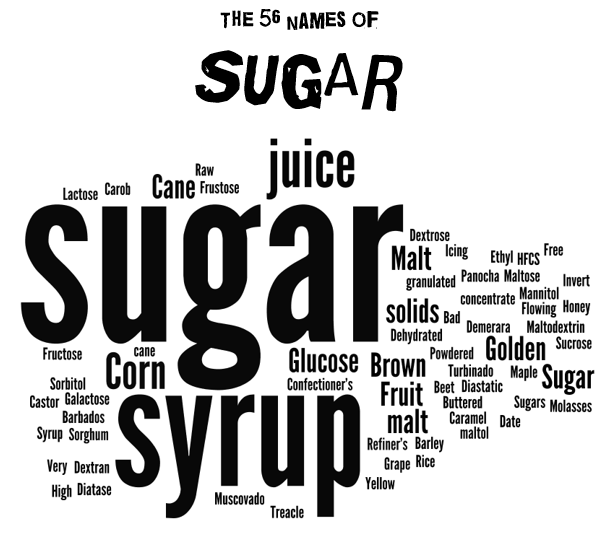So sugar is the new tobacco, but is agave ok? Dates are out, but apples are in? And if your cane sugar is organic, does that make a difference? If you’re confused about which sugars are good or bad, and what sugar even is, you’re not the only one. To break it down, we’re going back to basics with a chemistry lesson.
Sugar 101
In its simplest form, sugar is a single molecule, such as glucose, fructose and galactose. These molecules (called monosaccharides) can pair up in different combinations to make other forms of sugar such as sucrose, lactose and maltose (these are called disaccharides). For example, in the case of regular table sugar, glucose + fructose = sucrose.
While the term “sugar” is most often used synonymously with cane sugar, it actually encompasses any substance that is made up of these sugar molecules. A few common non-cane sugars include agave, coconut sugar/nectar, honey, maple syrup and date syrup. You might spot a few others you recognise in the word cloud at the end of this post.
All sugars are not created equal
In the health food industry, we tend to focus on whether sugar is refined or not. That’s important (we’ll get to that), but we also need to look at the breakdown of glucose and fructose for each type of sugar. Sweeteners may be glucose based (rice malt syrup), mostly fructose (agave) or a fairly even split of both, in the form of sucrose (white, raw and rapadura sugar).
Glucose, your body’s preferred energy source, is the most useful of all the sugars. Your body actually makes glucose in the process of digesting carbohydrates, which it then stores or uses for energy. If we’re going to eat sugar in any form, this the easiest for your digestive system to process, and the least likely to cause harm.
Fructose, on the other hand, is not a preferred energy source for muscles and the brain, and it has a different metabolic pathway to glucose. Fructose is metabolised in the liver and is more lipogenic (fat-producing) than glucose. Remember, the high concentration of fructose when it’s added to our food, even to ‘healthy’ foods like granola, enables us to consume way more than we could stuff down in its natural, fibrous form. We’re not talking about eating an apple, we’re talking about fructose added to food in a concentrated, syrupy form.
The fructose load
Studies show that diets high in added fructose can lead to all sorts of health complications including fatty liver, insulin resistance, Type 2 diabetes, obesity, autoimmune disorders and cardiovascular disease. The unique metabolic pathway of fructose means that over consumption puts a toxic load on the liver. Over consumption is somewhat inevitable due to the fact that fructose does not stimulate the production of two key hormones involved in regulating appetite and energy homeostasis - insulin and leptin. In fact, the addictive nature of fructose makes it all but impossible for some people to stop eating once they start.
A spoonful of sugar
Obviously, too much sugar, particularly fructose, is not a good thing. But how much is too much? The World Health Organisation (WHO) recommends that no more than 5% of our daily energy intake come from ‘free sugars’, which are defined as any form of sugar that has been added to food, or that is present in honey, syrups, fruit juices, and fruit concentrates. The recommendation is based on plentiful and firm scientific evidence linking free sugar consumption of >10% with increased incidence of obesity and dental caries, and vice versa. Auxiliary scientific studies provide the basis for the WHO’s further reduction of the recommended intake to 5%, which equates to around about 6 teaspoons of free sugars per day for women (9 teaspoons for men). Put another way, 1 teaspoon of sugar is equivalent to 4 grams, so your daily intake of free sugars would ideally be 24 grams or less.
Educate thyself
Reading food labels is a whole other minefield, but should be easier if you head out equipped with some knowledge about the different names of sugar, which sugars are high in fructose, and how much you want to consume in one day. Pay particular attention to health foods that are loaded with dried fruit, dates, agave and other natural sweeteners. It’s fine to eat these things, but be aware of how much sugar you’re eating in one go, and perhaps reduce your intake elsewhere in the day to accommodate for it.
Want to learn more? Some sugar education resources we rate:
That Sugar Film - and entertaining and uniquely Australian take on the sugar issue, and an alarming look at how 'hidden' sugars can sneak into the seemingly healthy diet.
I Quit Sugar - infographics, latest nutrition news, recipe ideas and an 8 week program for quitting the white stuff.
Radiant Recovery - Kathleen Desmaisons, Ph.D. on sugar addiction and how to break the cycle. Her book Potatoes Not Prozac is a must read for anyone who's never been able to stop at just one Tim Tam.
Image via www.giveuplovingpop.org.uk



